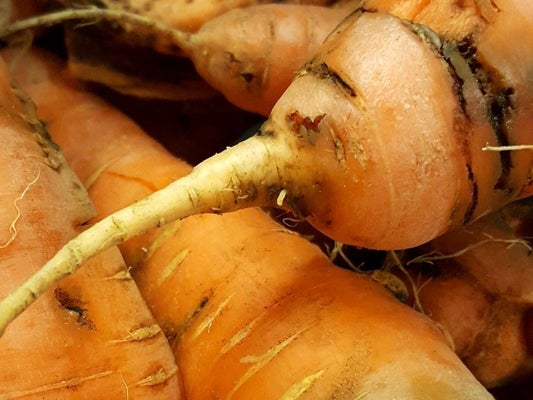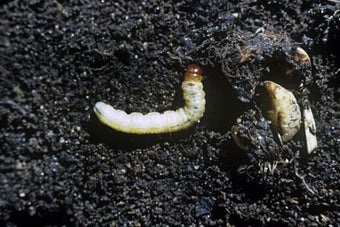
Quick facts
Common name - Carrot fly
Scientific name - Psila rosae
Plants affected - Carrot, parsnip, parsley, celeriac and celery
Main symptoms - Rusty brown tunnels in the tap roots. Slender creamy yellow maggots may be seen in the roots
Most active - May-October
What is carrot fly?
Carrot fly is a small black-bodied fly whose larvae feed on the roots of carrots and related plants, such as parsnip, parsley, celery and celeriac.
Symptoms
- Rusty brown scars ring the tap roots of carrot and other susceptible vegetables, making them inedible, and susceptible to secondary rots
- When the roots are cut through, tunnels are revealed, often inhabited by slender creamy-yellow maggots up to 9 mm (3/8 in) long

Management
- Sow sparsely to avoid the . Female carrot flies searching for egg-laying opportunities are attracted by the smell released when surplus plants are removed
- Late sown carrots (after mid-May) avoid the first generation of the fly; similarly carrots harvested before late August avoid the second generation
- Protect vulnerable crops by covering the plants with insect-proof netting. It is essential to practise crop rotation with this method, otherwise adult carrot flies may emerge within the protected crop from overwintered pupae in the soil. RHS research has shown that a complete covering is more effective than a barrier, read about our research here: how to protect your carrots
- Choose carrot cultivars that are less susceptible to carrot fly, such as 'Fly Away', 'Maestro', 'Resistafly' and 'Sytan'. These cultivars are less susceptible to carrot fly, rather than being fully resistant
- A mixture of pathogenic nematodes, sold as 'Fruit and Vegetable Protection', can be watered into the soil to control the young larvae. These nematodes are not specific to carrot root fly larvae and will affect other insects in the soil. This is available by mail order from biological control suppliers
- Separate species of nematode are also available by mail order from biological control suppliers; for spring treatment Steinernema feltiae and for summer treatment S. carpocapsae.
Downloads
Biological control suppliers (Adobe Acrobat pdf document listing biological control and suppliers)
Biology and research
Biology
- The maggots hatch from eggs laid in late May-June and in August-September
- Newly-hatched larvae feed on the fine roots but later bore into the tap roots. The brown scars are where tunnels near the root surface have collapsed
- Two or three generations of carrot fly can develop between late spring and autumn, with the insect overwintering as larvae or pupae
Research
RHS research has compared different heights of barriers and complete covering with netting as methods of control of carrot root fly. The results have been interpreted and have informed the advice given on carrot fly and growing and protecting carrots.
See more about the original research aims >









